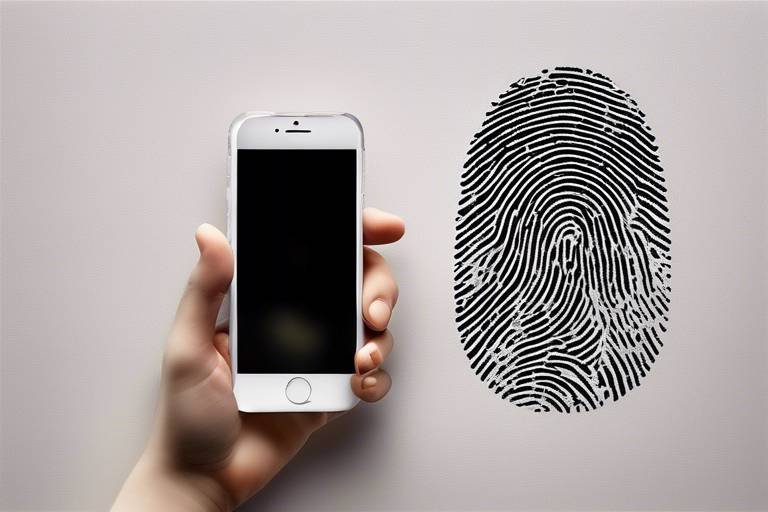Smartphone Safety: Protecting Your Personal Information
In today's digital age, smartphones have become an integral part of our lives, acting as our personal assistants, communication devices, and gateways to the internet. However, with great convenience comes great responsibility. Our smartphones hold a treasure trove of personal information, from banking details to private messages. This makes them prime targets for cybercriminals. So, how can we ensure that our personal information remains secure? In this article, we will explore essential strategies for safeguarding your data on smartphones, diving into best practices, common threats, and effective tools that can enhance your security and privacy.
Smartphones are not just communication devices; they are mini-computers that can be susceptible to a variety of security threats. Understanding these vulnerabilities is the first step in protecting your personal information. Some of the most common threats include:
- Malware: Malicious software can infiltrate your device through apps or links, stealing sensitive information without your knowledge.
- Phishing: Cybercriminals often use deceptive emails or texts to trick users into providing personal information.
- Unsecured Networks: Connecting to public Wi-Fi networks can expose your data to hackers who may be lurking on the same network.
By being aware of these threats, you can take proactive steps to protect your smartphone and the valuable information it contains.
Effective password management is crucial for smartphone security. Weak passwords are like leaving your front door open; they invite unwanted guests. Here are some strategies for creating strong passwords:
- Use a mix of uppercase and lowercase letters, numbers, and symbols.
- Avoid using easily guessable information such as birthdays or names.
- Consider using a password manager to generate and store complex passwords securely.
By following these practices, you can significantly reduce the risk of unauthorized access to your accounts.
Two-factor authentication (2FA) adds an extra layer of security to your accounts. It's like having a second lock on your door. Enabling 2FA requires you to provide not only your password but also a second piece of information, such as a code sent to your phone. This makes it much harder for intruders to gain access to your sensitive information.
There are several methods for 2FA, including:
- SMS Codes: A code is sent to your phone via text message.
- Authentication Apps: Apps like Google Authenticator or Authy generate codes for you.
- Email Codes: A code is sent to your registered email address.
While SMS codes are convenient, they can be intercepted. Authentication apps provide a more secure alternative, making them a popular choice among security-conscious users.
Many users make mistakes when setting up 2FA. Common pitfalls include:
- Using easily guessable codes.
- Failing to back up recovery codes.
- Neglecting to enable 2FA on all accounts.
By avoiding these mistakes, you can ensure your accounts remain secure and less susceptible to breaches.
Keeping your smartphone's software up to date is vital for security. Software updates often include patches for known vulnerabilities. Ignoring these updates is like leaving a window open during a storm; it invites trouble. Regularly updating your device ensures that you are protected against the latest threats and exploits.
Phishing scams are a significant threat to smartphone users. These scams can come in various forms, such as emails, texts, or even phone calls, all designed to trick you into revealing personal information. Recognizing these attempts is crucial in avoiding falling victim to them.
Not all links are safe. To recognize suspicious links, look for:
- Unusual sender addresses.
- Misspellings in the URL.
- Requests for personal information.
If you accidentally click on a suspicious link, it’s important to act quickly. Change your passwords and monitor your accounts for any unauthorized activity.
If you encounter a phishing attempt, reporting it is crucial. By doing so, you help protect others from falling victim to the same scams. You can report phishing attempts to:
- Your email provider.
- The Federal Trade Commission (FTC).
- Local authorities if necessary.
Taking action not only helps you but also contributes to a safer online environment for everyone.
Choosing secure apps is essential for protecting personal information. Not all apps are created equal; some may collect more data than necessary or lack proper security measures. It's important to review app permissions and read privacy policies before downloading.
Understanding app permissions can help safeguard your data. Regularly review the permissions granted to your apps, and consider revoking any that seem excessive. For instance, why would a flashlight app need access to your contacts?
There are many third-party apps designed to enhance smartphone security. Some of the best options include:
- Antivirus Software: Protects against malware and viruses.
- VPN Services: Encrypts your internet connection for added privacy.
- Password Managers: Safely stores and manages your passwords.
By utilizing these tools, you can create a more secure digital environment for yourself.
Q: What should I do if I think my smartphone has been hacked?
A: If you suspect your smartphone has been compromised, immediately change your passwords, run a security scan with antivirus software, and consider restoring your device to factory settings.
Q: How often should I update my smartphone's software?
A: It's best to update your smartphone's software as soon as updates are available to ensure you have the latest security patches.
Q: Is it safe to use public Wi-Fi?
A: Public Wi-Fi can be risky. If you must use it, consider using a VPN to encrypt your connection and protect your data.

Understanding Smartphone Vulnerabilities
Smartphones have become an integral part of our daily lives, acting as our personal assistants, entertainment hubs, and gateways to the world. However, with great power comes great responsibility, and in this case, the responsibility lies in protecting your personal information. Smartphones are prone to various security threats that can compromise your data and privacy. Understanding these vulnerabilities is the first step towards safeguarding your information.
One of the most common threats is malware. This malicious software can infiltrate your device through seemingly innocent apps or links. Once inside, it can steal personal information, track your activity, or even lock you out of your own device. Malware can be sophisticated, often disguising itself as legitimate software, which makes it crucial to only download apps from trusted sources.
Another significant threat is phishing. Cybercriminals often use deceptive emails or messages to trick users into revealing sensitive information, such as passwords or credit card numbers. These phishing attempts can appear very convincing, often mimicking legitimate companies. It's essential to be cautious about unsolicited communications and to verify the authenticity of any requests for personal information.
Additionally, smartphones frequently connect to unsecured networks, such as public Wi-Fi. While convenient, these networks can expose your data to hackers who are lurking nearby. When you connect to an unsecured network, your information can be intercepted, leading to identity theft or unauthorized access to your accounts. To mitigate this risk, consider using a VPN (Virtual Private Network) when accessing public networks, which encrypts your data and shields it from prying eyes.
In summary, the primary vulnerabilities that threaten smartphone security include:
- Malware: Malicious software that can steal or compromise your data.
- Phishing: Deceptive tactics used to trick you into giving away personal information.
- Unsecured Networks: Public Wi-Fi connections that expose your data to hackers.
By understanding these vulnerabilities, you can take proactive measures to protect your personal information. Awareness is the first line of defense against the myriad of threats that lurk in the digital shadows. Stay informed, remain vigilant, and always prioritize your smartphone's security.

Best Practices for Password Management
In today’s digital age, managing your passwords effectively is not just a good idea; it's a necessity. Think of your password as the key to your digital home. If you wouldn’t hand your house key to a stranger, why would you use weak or easily guessable passwords? A strong password acts as your first line of defense against unauthorized access to your personal information. The best practices for password management include creating complex passwords, using password managers, and regularly updating your passwords.
First off, let’s talk about what makes a strong password. A good password should be at least 12 characters long and include a mix of uppercase letters, lowercase letters, numbers, and special characters. Imagine trying to crack a safe; the more complex the combination, the harder it is to break in. For instance, instead of using something simple like "password123," consider something like "G@t3h0us3!2023". This not only makes it tougher for hackers but also helps you feel more secure.
Next, utilizing a password manager can be a game-changer. These tools can generate and store complex passwords for you, making it easy to manage multiple accounts without the fear of forgetting them. With a password manager, you only need to remember one master password. It’s like having a safe where you can keep all your keys without worrying about losing them. Popular options include LastPass, 1Password, and Bitwarden. Each of these tools offers robust security features, so you can pick one that fits your needs.
Moreover, regularly updating your passwords is essential. Just like you wouldn’t want to wear the same outfit every day, you shouldn’t stick to the same password indefinitely. Aim to change your passwords every three to six months. This practice helps minimize the risk of someone gaining unauthorized access to your accounts. If you suspect that your password has been compromised, change it immediately! Remember, the sooner you act, the less likely you are to fall victim to identity theft.
Implementing two-factor authentication (2FA) is another critical step in password management. This method requires not only your password but also a second form of verification, such as a text message code or an authentication app. It’s like adding a second lock to your door; even if someone has your key, they still can’t get in without that second lock. Enabling 2FA on your accounts significantly enhances security, making it much harder for cybercriminals to gain access.
When it comes to two-factor authentication, you have several options. You can choose between receiving SMS codes, using authentication apps like Google Authenticator, or even biometric methods like fingerprint scanning. Each method has its pros and cons. For instance, while SMS codes are convenient, they can be intercepted. On the other hand, authentication apps are generally more secure. Evaluate your needs and choose the method that offers the best balance of security and convenience for you.
While setting up 2FA is a great step, many users make common mistakes that can undermine their efforts. One frequent error is not keeping backup codes in a secure place. These codes are your lifeline if you lose access to your primary authentication method. Another mistake is using the same method for multiple accounts. If one account is compromised, others can be too. Always diversify your security measures to ensure maximum protection.
In conclusion, effective password management is essential for safeguarding your personal information on smartphones. By creating strong passwords, utilizing password managers, regularly updating your passwords, and implementing two-factor authentication, you can significantly reduce the risk of unauthorized access. Remember, your digital security is in your hands, so take the necessary steps to protect it!
- What is the importance of a strong password?
A strong password is crucial as it acts as the first line of defense against unauthorized access to your accounts. - How often should I change my passwords?
It is recommended to change your passwords every three to six months. - What is two-factor authentication?
Two-factor authentication (2FA) adds an extra layer of security by requiring a second form of verification in addition to your password. - Are password managers safe to use?
Yes, password managers are designed to securely store and manage your passwords, making them a safe option if you choose a reputable one.

Two-Factor Authentication
In today’s digital landscape, protecting your personal information is more important than ever, and one of the most effective tools at your disposal is Two-Factor Authentication (2FA). Imagine locking your front door but also installing a high-tech security system that requires a code to enter. That’s precisely what 2FA does for your online accounts. By requiring not just a password but also a second form of verification, you create an additional barrier against unauthorized access.
Enabling 2FA is a straightforward process, and it can significantly enhance your security. Most major online services offer this feature, and setting it up typically involves linking your account to a mobile app or receiving a text message with a verification code. Once activated, even if someone manages to steal your password, they would still need that second piece of information to gain access. This double layer of security is akin to having both a key and a security badge to enter a building. It’s a simple step that can provide peace of mind.
But why is 2FA so crucial? Consider this: according to recent studies, the likelihood of your account being compromised increases dramatically without it. Cybercriminals are constantly evolving their tactics, and passwords alone are no longer sufficient to keep your information safe. By implementing 2FA, you’re taking a proactive stance against potential threats. It’s like wearing a seatbelt; you hope you never need it, but it’s a smart move just in case.
When it comes to choosing the right method for 2FA, you have several options. Here are the most common:
- SMS Codes: A text message containing a code is sent to your phone each time you log in.
- Authentication Apps: Applications like Google Authenticator or Authy generate time-sensitive codes that you need to enter.
- Email Verification: A code is sent to your email, which you must enter to complete the login process.
Each method has its pros and cons. SMS codes are convenient but can be intercepted. Authentication apps provide better security but require you to have your phone handy. It’s essential to weigh these options and choose the one that best fits your lifestyle and security needs.
However, many users make mistakes when setting up 2FA, which can undermine its effectiveness. Common pitfalls include:
- Using easily guessable backup codes.
- Failing to update your phone number associated with the account.
- Neglecting to enable 2FA on all accounts that offer it.
To ensure you’re using 2FA effectively, regularly review your settings and make adjustments as needed. Remember, just like any security measure, 2FA is only as strong as the user’s commitment to maintaining it. So, take the time to educate yourself on the best practices for this essential tool.
In summary, enabling Two-Factor Authentication is a crucial step in safeguarding your personal information. It adds a robust layer of security that can significantly reduce the risk of unauthorized access to your accounts. Don’t wait until it’s too late; activate 2FA today and take control of your digital safety!

Choosing the Right 2FA Method
When it comes to securing your digital life, two-factor authentication (2FA) is a game changer. But with several methods available, how do you choose the right one for your needs? Each method has its pros and cons, and understanding these can help you make an informed decision. Let's break it down!
Firstly, you have the classic method: SMS codes. This is where you receive a text message with a code every time you log in. It’s convenient, no doubt, but it’s not the most secure option. Why? Because if someone gains access to your phone number, they can intercept those messages. Imagine leaving your front door unlocked, thinking it’s safe just because you’re home. That’s how SMS codes can feel.
Next up are authentication apps, like Google Authenticator or Authy. These apps generate a unique code every 30 seconds, which you enter when logging in. They’re much more secure than SMS codes because they don't rely on your phone number. Think of it as having a personal bodyguard that only you can access. However, you must remember to back up your codes because if you lose your phone, retrieving access can be tricky.
Then there’s the option of hardware tokens. These are physical devices that generate codes or connect directly to your device. They offer the highest level of security, but they come at a cost and can be inconvenient if you forget to carry them. It’s like having a safe deposit box: super secure, but you need to be physically present to access it.
Lastly, biometric methods, such as fingerprint or facial recognition, are becoming increasingly popular. They offer a seamless user experience—just touch or glance to unlock! However, they can be less effective if your device fails to recognize you or if your biometric data is compromised. It’s like having a key that only works sometimes; it’s handy, but you might get locked out.
In summary, here are the main methods of 2FA, alongside their security levels and convenience:
| 2FA Method | Security Level | Convenience |
|---|---|---|
| SMS Codes | Medium | High |
| Authentication Apps | High | Medium |
| Hardware Tokens | Very High | Low |
| Biometric Methods | Medium | Very High |
Ultimately, the right 2FA method for you depends on your personal needs and how much you value security over convenience. Consider your lifestyle and the sensitivity of the information you’re protecting. Remember, no method is foolproof, but using 2FA is a significant step towards keeping your personal information safe!
1. What is Two-Factor Authentication?
2FA is a security process that requires two forms of identification before granting access to an account, enhancing security.
2. Is SMS-based 2FA safe?
While it offers an additional layer of security, SMS codes can be intercepted, making them less secure than other methods.
3. Can I use multiple 2FA methods?
Yes! Many services allow you to enable more than one method for added security.
4. What should I do if I lose my phone with my 2FA app?
Most authentication apps offer recovery options, such as backup codes. Always keep these codes in a safe place.
5. Are biometric methods reliable?
Biometric methods are generally reliable but can fail due to various factors, such as lighting or device issues.

Common 2FA Mistakes
When it comes to two-factor authentication (2FA), many users think they're safe just by enabling it. However, there are several common mistakes that can undermine the very security that 2FA is supposed to provide. One of the biggest blunders is using an easily guessable second factor, like SMS codes. While SMS is better than nothing, it can be intercepted, making it less secure. Instead, consider using an authentication app, which generates time-sensitive codes that are much harder for attackers to access.
Another frequent mistake is neglecting to back up recovery codes. When you set up 2FA, you're typically given a set of recovery codes to use if you lose access to your primary authentication method. If you don't save these codes in a secure place, you might find yourself locked out of your account. It’s like having a spare key to your house but forgetting where you put it! Make sure to write them down and store them safely.
Moreover, many users fall into the trap of reusing the same authentication method across multiple accounts. This is a risky strategy because if one account gets compromised, others using the same method could easily fall prey as well. To enhance your security, utilize a variety of 2FA methods across different accounts. For instance, if you use an SMS code for one account, consider switching to an authentication app for another.
Lastly, failing to update your 2FA settings when changing devices can lead to unnecessary headaches. If you switch phones or change your number, remember to update your 2FA settings accordingly. Otherwise, you may end up unable to access your accounts when you need them most. Always keep your security measures aligned with your current devices.
In summary, while 2FA is a powerful tool for enhancing security, it’s essential to avoid these common pitfalls. By being aware of these mistakes and taking proactive steps to mitigate them, you can significantly improve your personal information security on smartphones.
- What is two-factor authentication (2FA)?
2FA is an additional security layer that requires not only a password and username but also something that only the user has on them, such as a physical token or a smartphone app that generates a time-sensitive code.
- Is SMS a secure method for 2FA?
While SMS adds a layer of security, it is not the most secure option due to risks like SIM swapping. It's advisable to use authentication apps instead.
- What should I do if I lose my 2FA device?
If you lose your device, use the backup recovery codes provided during the 2FA setup to regain access. If you don't have those, contact the service provider for recovery options.

Regular Software Updates
Keeping your smartphone's software up to date is not just a good habit; it's a vital defense mechanism against potential threats lurking in the digital shadows. Think of your smartphone as a fortress. Each update is like adding a new layer of bricks, reinforcing the walls against the relentless attacks of hackers and malware. When you ignore these updates, you're essentially leaving the gates wide open, inviting intruders to waltz right in and access your personal information.
Every time a software update is released, it often includes security patches designed to fix vulnerabilities that have been discovered since the last update. These vulnerabilities can be exploited by cybercriminals to gain unauthorized access to your device and data. By regularly updating your smartphone, you ensure that you’re protected against the latest threats. In fact, many recent cyberattacks have targeted outdated software, proving just how crucial it is to stay current.
But it's not just about security; updates can also enhance the overall performance of your device. They often come with bug fixes, improved features, and even new functionalities that can make your smartphone experience smoother and more enjoyable. So, why not take advantage of these improvements? Regularly checking for updates and installing them can turn your smartphone into a well-oiled machine, ready to tackle whatever the day throws at you.
To make this process easier, many smartphones offer automatic updates. This feature allows your device to download and install updates without you needing to lift a finger. However, it’s essential to ensure that this feature is enabled. You can typically find this option in your device’s settings under 'Software Update' or 'System Update.' If you prefer to manually check for updates, here’s a quick guide:
- Go to Settings.
- Scroll down and select About Phone or Software Update.
- Tap on Check for Updates.
- If an update is available, follow the prompts to download and install.
In conclusion, regular software updates are a simple yet powerful way to protect your personal information and enhance your smartphone's performance. It’s a small effort that can yield significant benefits, ensuring your device remains secure and efficient. So, don’t wait—check for updates today and fortify your digital fortress!
Q: How often should I update my smartphone?
A: It's best to check for updates at least once a month, or enable automatic updates to ensure you never miss an important security patch.
Q: What happens if I ignore software updates?
A: Ignoring updates can leave your device vulnerable to security threats and may result in performance issues as outdated software can cause bugs and glitches.
Q: Can I update my smartphone without Wi-Fi?
A: Yes, you can use mobile data to download updates, but it’s recommended to use Wi-Fi to avoid excessive data charges, especially for larger updates.
Q: Will updating my smartphone delete my data?
A: No, software updates typically do not delete your data. However, it’s always a good practice to back up your data before performing any updates, just in case.

Recognizing Phishing Scams
Phishing scams are like modern-day treasure maps, but instead of leading you to gold, they often take you straight to the heart of a digital nightmare. These scams are designed to trick you into revealing your personal information, such as passwords, credit card numbers, and social security details. With the rise of smartphones, these scams have become more sophisticated, making it essential for you to stay vigilant. So, how can you arm yourself against these sneaky attacks? Let’s dive into some practical strategies to help you recognize phishing attempts before they can do any harm.
First and foremost, always be skeptical of unsolicited messages. Whether it’s an email, text, or social media message, if it comes from an unknown source and asks for sensitive information, raise your guard. Phishing messages often create a sense of urgency, pushing you to act quickly without thinking. For example, you might receive a message claiming that your bank account has been compromised and that you need to verify your information immediately. Take a step back and ask yourself: is this really from my bank? If it feels off, it probably is.
Next, look for red flags in the message itself. Phishing scams often contain poor grammar, spelling mistakes, or awkward phrasing. Legitimate companies typically maintain a professional tone, so if you notice anything that seems out of place, it’s a sign to proceed with caution. Additionally, hover over any links in the message (without clicking!) to see the actual URL. If the link looks suspicious or doesn’t match the company’s official website, don’t click it! Instead, go directly to the website by typing the URL into your browser.
Another effective strategy is to verify the sender. If you receive a message from your bank, for instance, don’t respond directly to the email or click any links. Instead, contact your bank through their official website or customer service number. This simple step can help you avoid falling into a trap. Remember, legitimate companies will never ask for sensitive information via email or text.
Finally, consider using tools and apps designed to help you identify and block phishing attempts. Many security applications offer features that can recognize suspicious links and warn you before you click. By incorporating these tools into your smartphone security arsenal, you can significantly reduce the risk of falling victim to phishing scams.
In summary, recognizing phishing scams is all about being aware and taking the time to double-check. By staying informed and cautious, you can protect your personal information and enjoy the benefits of your smartphone without fear. Remember, if something seems too good to be true or feels off, trust your instincts and investigate further.
- What should I do if I think I've fallen for a phishing scam? If you suspect you've been targeted, immediately change your passwords and contact your bank or service provider. It's also wise to monitor your accounts for any unauthorized transactions.
- Can phishing scams happen on social media? Absolutely! Phishing can occur on any platform where you share personal information. Always be cautious about friend requests and messages from unknown users.
- Are there any signs that indicate a phishing attempt? Yes, look for poor grammar, urgent requests for personal information, and suspicious links. If it seems off, it’s best to ignore it.

Spotting Suspicious Links
In today's digital world, where our smartphones are almost like an extension of ourselves, being aware of suspicious links is crucial. These links can lead to phishing websites designed to steal your personal information, and they often masquerade as legitimate URLs. So, how can you spot these deceptive links before it's too late? First off, always look closely at the URL. Legitimate websites typically have a clear and recognizable web address. If you see a link that has misspellings, unusual characters, or a strange domain (like .xyz instead of .com), it’s a red flag.
Moreover, consider the context in which you received the link. If it was sent via a text message or an email from an unknown sender, proceed with caution. Cybercriminals often use social engineering tactics to trick you into clicking on their links. For instance, they might create a sense of urgency, claiming that your account will be suspended unless you act immediately. Remember, if it sounds too good to be true, it probably is!
Another effective way to spot suspicious links is by hovering over them (if you're on a computer) to see the actual URL. On a smartphone, you can usually long-press the link to preview it. This will help you determine whether it leads to a legitimate site or a potential scam. Additionally, pay attention to the protocol of the link. Secure websites typically start with https:// rather than just http://, indicating that they have a security certificate. However, just because a link starts with https:// does not mean it’s safe; always verify the source.
Here are a few more tips to help you identify suspicious links:
- Check for shortened URLs: Services like bit.ly can obscure the actual destination of a link. Use a URL expander to see where it leads before clicking.
- Look for unexpected requests: If someone you know sends you a link out of the blue, especially if it seems unrelated to your conversation, verify with them before clicking.
- Be wary of pop-ups: If a website prompts you to click on a link or download something immediately, it's often a sign of a phishing attempt.
Lastly, if you accidentally click on a suspicious link, don’t panic. Immediately close the webpage and check your device for any unusual behavior. Run a security scan if you have antivirus software installed. Keeping your smartphone secure is a continuous process, and being vigilant about suspicious links is a significant part of that.

Reporting Phishing Attempts
Encountering a phishing attempt can be alarming, but how you respond can make a significant difference. When you come across a suspicious email, message, or link, it's essential to take action—not just for your own safety but for the protection of others as well. Reporting phishing attempts helps authorities track down cybercriminals and can prevent them from targeting more unsuspecting individuals.
First and foremost, you should identify the platform where you encountered the phishing attempt. Different platforms have different reporting procedures. For instance, if you received a phishing email, you can report it directly to your email provider. Most major providers, like Gmail and Outlook, have a straightforward process for flagging such emails. Simply look for the "Report Spam" or "Report Phishing" option, which is usually found in the settings or options menu of your inbox.
On social media platforms, reporting is also quite simple. Most platforms like Facebook, Twitter, and Instagram have built-in features that allow users to report suspicious accounts or messages. When you report a phishing attempt, be sure to provide as much detail as possible. This includes:
- The URL of the phishing site, if applicable.
- The sender's email address or the username of the account that contacted you.
- A brief description of the phishing attempt and how it was presented.
Additionally, if the phishing attempt involves sensitive data, such as your bank information or social security number, consider reaching out to your bank or relevant authorities to alert them about the potential compromise. This proactive measure can help mitigate any damage that might occur from identity theft or fraud.
For a more comprehensive approach, you can also report phishing attempts to dedicated organizations. In the United States, for example, the Federal Trade Commission (FTC) encourages individuals to report phishing scams through their website. Similarly, the Anti-Phishing Working Group (APWG) is a global organization that collects and analyzes phishing data. By reporting to these organizations, you contribute to a larger effort to combat cybercrime.
Remember, the more information you provide when reporting phishing attempts, the better equipped these organizations will be to take action. It’s like being a detective in your own right, helping to piece together the puzzle of online security. By taking these steps, you not only protect yourself but also help create a safer online environment for everyone.
- What should I do if I clicked on a phishing link? If you've clicked on a phishing link, immediately disconnect from the internet and run a security scan on your device. Change any passwords that may have been compromised and monitor your accounts for unusual activity.
- Can I report phishing attempts anonymously? Yes, many platforms allow you to report phishing attempts without revealing your identity. However, providing your contact information can help authorities follow up if needed.
- How can I educate others about phishing scams? Share your knowledge! Talk to friends and family about the signs of phishing and encourage them to report any suspicious activities they encounter.

Using Secure Apps and Services
In today's digital landscape, choosing secure apps is more critical than ever for safeguarding your personal information. With the plethora of applications available, it can be overwhelming to determine which ones are trustworthy. The first step is to always download apps from reputable sources, such as the Apple App Store or Google Play Store. These platforms typically have stringent security checks in place, reducing the risk of malware or malicious software.
When selecting apps, it's essential to pay attention to the developer's reputation. A quick internet search can reveal user reviews and ratings that provide insight into the app's reliability. Additionally, reading through the app's privacy policy is crucial. Although it may seem tedious, this document outlines how your data will be used and shared. If an app does not have a clear privacy policy or if it seems overly invasive, it might be best to look for alternatives.
Another vital aspect to consider is the permissions that apps request upon installation. Many apps ask for access to your contacts, camera, or location, which may not be necessary for their primary function. For instance, a simple flashlight app should not need access to your contacts. By reviewing and managing app permissions, you can significantly minimize your data exposure. Here’s a quick guide to help you:
- Review permissions before installation: Always check what permissions an app is requesting before you hit that install button.
- Regularly audit app permissions: Go into your smartphone settings and review the permissions for each app periodically.
- Limit permissions: If an app requests permissions that seem excessive, consider denying them or uninstalling the app altogether.
Furthermore, consider using third-party apps designed to enhance your smartphone's security. These applications can provide additional layers of protection, such as VPNs (Virtual Private Networks), antivirus software, and secure messaging services. For example, a reputable VPN can encrypt your internet connection, making it much harder for hackers to intercept your data, especially when using public Wi-Fi networks.
Below is a table comparing some popular security apps that can help protect your personal information:
| App Name | Type | Key Features |
|---|---|---|
| Norton Mobile Security | Antivirus | Malware protection, web protection, and Wi-Fi security |
| ExpressVPN | VPN | High-speed connection, no-log policy, and 24/7 customer support |
| Signal | Messaging | End-to-end encryption, self-destructing messages, and voice/video calls |
In conclusion, using secure apps and services is paramount for protecting your personal data in a world filled with digital threats. By being proactive—researching apps, managing permissions, and utilizing security applications—you can create a safer smartphone experience. Remember, your personal information is valuable; taking these steps can help ensure it remains protected.
Q: How can I tell if an app is secure?
A: Look for apps with high ratings, positive reviews, and a clear privacy policy. Always download from official app stores.
Q: What should I do if an app requests unnecessary permissions?
A: You can deny the permissions or uninstall the app if it seems overly intrusive.
Q: Are third-party security apps worth it?
A: Yes, reputable third-party security apps can provide additional layers of protection for your data.

App Permissions
Understanding is crucial for safeguarding your personal data on smartphones. When you download an app, it often requests access to various features on your device, such as your camera, contacts, location, and more. While some permissions are necessary for the app to function correctly, others may be excessive or intrusive. For instance, why would a simple flashlight app need access to your contacts? This is a question that every user should ask themselves.
To maintain your privacy, it’s essential to review and manage app permissions regularly. Most smartphones allow you to check the permissions granted to each app in the settings menu. Here’s how you can do it:
- Go to your phone's Settings.
- Select Apps or Applications.
- Choose the specific app you want to review.
- Tap on Permissions to see what access has been granted.
By taking this simple step, you can identify apps that may be overreaching in their permissions and take action to revoke unnecessary access. It’s like putting a lock on your diary; you wouldn’t want just anyone reading your private thoughts, right?
Moreover, it's wise to be cautious with apps from unknown developers. Always check the app's reviews and ratings in the app store before downloading. A reputable app will usually have a clear privacy policy outlining how it uses your data, which brings us to an important point: reading privacy policies.
Privacy policies can be lengthy and filled with legal jargon, but they provide valuable insights into how your data will be used. If an app's privacy policy seems vague or overly complex, consider it a red flag. Remember, your personal information is precious; treat it like gold and only share it with those who deserve it.
In summary, managing app permissions is a proactive measure you can take to protect your personal information. By regularly reviewing what access you’ve granted and being mindful of the apps you install, you can significantly reduce your risk of data breaches and privacy invasions.
Q1: What are app permissions?
App permissions are requests made by applications to access specific features or data on your device, such as your camera, location, or contacts.
Q2: How can I manage app permissions?
You can manage app permissions by going to your phone's settings, selecting the relevant app, and adjusting the permissions as needed.
Q3: What should I do if an app requests unnecessary permissions?
If an app requests permissions that seem excessive or unnecessary, consider not installing it or uninstalling it if it’s already on your device.
Q4: Are all apps safe to use?
Not all apps are safe. Always check the developer's reputation, read reviews, and review the app's privacy policy before downloading.

Third-Party Apps to Enhance Security
In today's digital age, relying solely on built-in smartphone security features is like trying to shield yourself from the rain with a flimsy umbrella. It's simply not enough! To truly safeguard your personal information, you should consider utilizing third-party security apps. These applications can provide an extra layer of defense against a myriad of threats, from malware to data breaches. But how do you choose the right ones? Let's dive into some of the top options available and what they can do for you.
One of the most popular categories of security apps is antivirus software. These apps are designed to detect and eliminate malicious software that can compromise your device. For instance, apps like McAfee Mobile Security and Norton Mobile Security not only scan for viruses but also offer features such as anti-theft measures and safe browsing tools. Imagine walking through a crowded market, knowing that you have a bodyguard by your side—this is what antivirus apps do for your smartphone.
Another essential type of app is a VPN (Virtual Private Network). VPNs encrypt your internet connection, making it nearly impossible for hackers to intercept your data. This is especially crucial when you’re using public Wi-Fi networks, which are notoriously insecure. Popular VPN options include ExpressVPN and NordVPN. Think of a VPN as a secure tunnel that shields your data from prying eyes as you navigate through the internet.
Additionally, consider using a password manager. These apps help you create and store strong, unique passwords for all your accounts, making it easier to maintain security without the hassle of remembering every single password. Tools like LastPass and 1Password are fantastic choices that not only save you time but also enhance your security posture significantly. It's akin to having a personal vault for all your sensitive information—safe, secure, and easily accessible.
Moreover, privacy-focused browsers can also enhance your security by blocking trackers and unwanted ads. Browsers like Brave and DuckDuckGo prioritize your privacy, ensuring that your online activities remain confidential. By using these browsers, you’re essentially putting on sunglasses to shield your eyes from the glaring lights of intrusive advertisements and tracking cookies.
It's also worth mentioning the importance of reviewing app permissions. Many apps request access to your contacts, camera, and location, which can be alarming. Apps like Permissions Manager allow you to manage these permissions effectively, ensuring that you only grant access to what is necessary. Think of it as a bouncer at a club; only the right guests get in!
While there are countless third-party apps available, it’s crucial to do your research. Always check reviews, look for reputable developers, and make sure the app has a solid privacy policy. In the vast sea of applications, some may not have your best interests at heart. To help you get started, here’s a quick comparison of some recommended third-party security apps:
| App Name | Type | Key Features |
|---|---|---|
| McAfee Mobile Security | Antivirus | Malware protection, anti-theft, safe browsing |
| NordVPN | VPN | Data encryption, secure browsing, no logs |
| LastPass | Password Manager | Password generation, secure vault, autofill |
| Brave | Privacy Browser | Ad blocking, tracker blocking, privacy-first |
In conclusion, incorporating third-party security apps into your smartphone routine is not just a smart move; it's essential for protecting your personal information. These tools can significantly enhance your security and provide peace of mind in an increasingly digital world. Remember, the goal is to create a multi-layered defense that keeps your data safe from various threats. So, equip yourself with the right apps, stay informed, and keep your smartphone secure!
- What is the best antivirus app for smartphones? The best app often depends on your specific needs, but popular options include McAfee and Norton.
- Are VPNs necessary for smartphone security? Yes, especially when using public Wi-Fi, as they encrypt your data and protect your privacy.
- How can I check app permissions on my smartphone? You can usually find this option in your device's settings under 'Apps' or 'Permissions.'
- Do password managers really improve security? Absolutely! They help create strong passwords and store them securely.
Frequently Asked Questions
- What are the common vulnerabilities that smartphones face?
Smartphones are susceptible to a variety of threats, including malware, phishing attacks, and unsecured Wi-Fi networks. These vulnerabilities can lead to unauthorized access to your personal information, making it essential to stay informed and take preventive measures.
- How can I create a strong password for my smartphone?
To create a strong password, use a combination of uppercase and lowercase letters, numbers, and special characters. Aim for at least 12 characters, and avoid using easily guessable information like birthdays or names. Consider using a password manager to help generate and store complex passwords securely.
- What is two-factor authentication (2FA) and why is it important?
Two-factor authentication (2FA) adds an extra layer of security by requiring not only your password but also a second form of verification, such as a code sent to your phone. This helps protect your accounts even if your password is compromised, making it a crucial step in safeguarding sensitive information.
- What are some common mistakes people make with 2FA?
Common mistakes include using SMS codes as the only method of 2FA, which can be intercepted, or failing to back up recovery codes. It's important to choose a more secure method, like authentication apps, and to keep your recovery options safe and accessible.
- Why are regular software updates important for smartphone security?
Regular software updates are vital because they often include security patches that fix vulnerabilities. By keeping your smartphone's operating system and apps up to date, you reduce the risk of cyberattacks and ensure your device is protected against the latest threats.
- How can I recognize phishing scams on my smartphone?
Phishing scams often come in the form of suspicious emails or messages that ask for personal information. Look out for poor grammar, generic greetings, and unexpected links. If something seems off, it’s best to avoid clicking on links or providing any information.
- What should I do if I accidentally click on a suspicious link?
If you accidentally click on a suspicious link, do not enter any personal information. Close the webpage immediately and run a security scan on your device. Additionally, consider changing passwords for any accounts that may have been compromised.
- How can I choose secure apps for my smartphone?
To choose secure apps, download them only from reputable sources like the Apple App Store or Google Play Store. Always read reviews and check the app's privacy policy to understand how your data will be used and stored.
- What are app permissions and why should I manage them?
App permissions determine what data and features an app can access on your device. Managing these permissions is crucial to minimize data exposure and protect your privacy. Regularly review and adjust permissions for each app to ensure they only have access to what they truly need.
- Are there third-party apps that can enhance my smartphone security?
Yes, there are several third-party apps designed to enhance smartphone security, such as antivirus software, VPNs, and secure messaging apps. Research and choose reputable options that fit your needs to provide an extra layer of protection for your personal information.



















